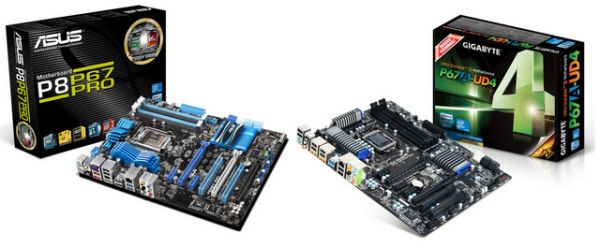The Battle of the P67 Boards - ASUS vs. Gigabyte at $190
by Ian Cutress on January 20, 2011 4:15 PM EST- Posted in
- Motherboards
- Gigabyte
- Asus
- P67
Final Words
Both the ASUS P8P67 Pro and Gigabyte P67A-UD4 motherboards offer a lot to consumers. For $190, we want a product that hits all the basic functionality of Sandy Bridge, and squeezes out as features and as much performance as possible at this price point.
For the ASUS board, we have a nice looking product with significant strengths in the implementation of their UEFI, and the auto overclockable functions available. The UEFI EZ mode/basic starting screen is something many manufacturers will copy over the upcoming months and UEFI visions. The auto-tuner section of Ai Suite will see use in all markets, aiding various retailers in offering ready-overclocked Sandy Bridge bundles with the P8P67 Pro. Intel gigabit Ethernet is nothing to be sniffed at, and the fan controls can only help improve the user experience. Also, bundle in that three-year warranty. On the downside, the BT GO! and Turbo Remote overclocking features via Bluetooth did not work for me.
The Gigabyte board performs on par with the ASUS board in terms of benchmarking – in most situations, there is almost nothing in it (except USB, where Gigabyte have the advantage there). The board is UEFI GUI absent (for now, supposedly), but thanks to BIOS updates, now supports 2.2TB+ hard drives. Overclocking via the BIOS is straightforward if you have ever overclocked before, and the myriad of software available in the OS will keep you hunting for options, trying to remember which setting is in which piece of software. The warranty, like the ASUS, is also three years. However, the BIOS updating issues I had are certainly worthy of note.
After playing with both boards, I can only come to one conclusion – if it were my money, I would take the ASUS P8P67 Pro over the Gigabyte P67A-UD4. With the ASUS board, you are getting a detailed UEFI, an awesome auto-overclocking tool, better energy saving features, a USB 3.0 bracket , more SATA 6 Gb/s ports, Intel gigabit Ethernet, and in my case, scope for a better overclock. The Gigabyte board is essentially expensive for what is on offer, in terms of usability, features, and extras.
However, the second question is: ‘what about the comparison to the ASRock P67 Extreme4’? The ASRock board has power/reset buttons on the board, a Debug LED, that USB 3.0 bracket which will hold an SSD (worth in my option about $15), and is almost $40 cheaper. The ASUS board is the slightly better performing, overclocking is easier on the ASUS, the ASUS has a longer warranty, the UEFI is slightly better on the ASUS, the ASUS uses Intel Ethernet rather than Realtek, but the ASRock will take socket 775 coolers. It is up to you to judge, but in my opinion, I would take the Extreme4, pocket the $40 difference, and invest it in something else for a PC build.
This then leads into the following question – ‘if I’d rather take a $150 board rather than a $190 board, why are there $300 boards available?’ That question is to be tackled over the coming months!











137 Comments
View All Comments
kmmatney - Monday, January 24, 2011 - link
Agreed. The last 3 motherboards I bought all came free (or close to it) in a Microcenter deal. 2 AMD system, and one Intel (socket 775). They all have decent overclocking, and have been plenty stable. Your better off spending the money you save on more RAM, or an SSD.MobiusStrip - Sunday, January 23, 2011 - link
"I'ma get that"You left out the wrong word. The "a" is the beginning of "a-gonna"; the phrase is "I'm a-gonna" do something. If you're going to remove something, it's the "a": I'm gonna get that.
softdrinkviking - Monday, January 24, 2011 - link
For all you know, "I'ma get that" could be widely used in this person's area, how would you know?Don't correct slang, it completely defeats the purpose, and it's kind of insane.
Sufo - Tuesday, January 25, 2011 - link
The "a" is the last a of gonna. The part that is omitted is the "gonn". If you're going to be such a useless pedant, at least get your facts straight.Not the best source, but http://en.wiktionary.org/wiki/Imma
"nope"
maxnix - Thursday, April 28, 2011 - link
Unfortunately for you, spell checking isn't one of them!Spazweasel - Thursday, January 20, 2011 - link
EVGA seems late to the game. They've announced their first 1155 board (130-SB-E675-KR) on their website, but has anyone actually seen it in the wild (much less reviewed)?seamusmc - Friday, January 21, 2011 - link
Spaz, (chuckle)I thought I read somewhere in their forums that EVGA's first P67 board will be available in February.
Spazweasel - Monday, January 31, 2011 - link
http://www.anandtech.com/show/4142/intel-discovers...Okay, now we know why!
It will be interesting to see if EVGA was among the first to be saying "Hey, something's not right here" and this was the reason.
DanNeely - Thursday, January 20, 2011 - link
The obvious feature gigabytes $260/320 board shas is PCIe bridge chips that allow a huge number of USB3 ports and more x16 slots, although you're only getting higher burst performance per device since they're all still sharing the same 16 lanes from the CPU.The other traditional feature is better mofsets/mofset coolers to allow higher voltages for overclocks if you have the cooling to handle the heat.
Pjmcnally - Thursday, January 20, 2011 - link
This is a great review that I was very happy to read. I picked up the ASRock board at release but I wasn’t sure I had made a good decision.I believe there is one small error in the review, the headers for both lists of board features read “ASRock P67 Extreme4” not “Asus P8P676 Pro” or “Gigabyte P67A-UD4”.